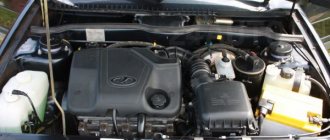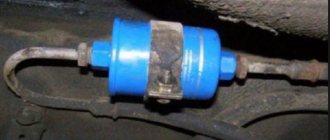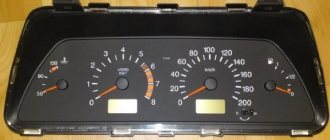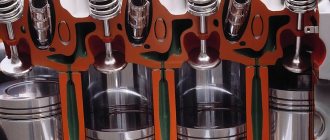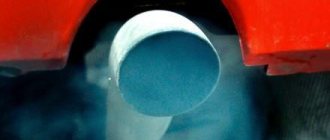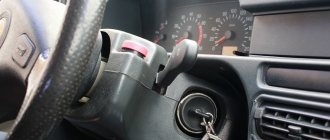The VAZ 2114 car was first presented to the general public back in 2001. Despite this, it took the manufacturer 2 years to launch it into production. This did not stop the car from becoming popular, and even at one time being the most purchased in the European part of Russia.
The VAZ 2114 is a deep modernization of the beloved “nine”, which for several decades maintained a leading position in the domestic automobile market. So the love for a new car did not arise out of nowhere. Indeed, it was very reminiscent of its predecessor, although, unlike the “chisel”, it had more modern forms, and therefore received a more affectionate nickname - “four”.
Over the ten years of production, the car has undergone changes more than once and yet has not lost its individuality. The production of this worthy representative of the glorious Lada family of cars was discontinued in 2013. But there is still quite a lot of interest in it. Let's take a closer look at the features of this popular favorite. The photo is shown in Fig. 1.
Car body
Looking at the Lada 2114 car strictly from the front, no one will ever say that it has anything to do with the “nine”. Indeed, it is this part of the body that has undergone the biggest changes. The first thing that catches your eye is the Lada bumper painted in body color. On the same nine it was considered tuning. In addition, the headlights and radiator grille have changed beyond recognition. The new hood and fenders have more rounded shapes.
But the designers were too lazy to work on the rear part of the body. He remained practically the same. Even the lanterns were not changed. The exceptions are a bumper in the color of the car itself and a spoiler with a brake light. Finishing with the review of the Lada body, it is worth noting that in general it was a success. The car looks very good, although perhaps by European standards the design cannot be called modern. But appearance is not the main thing.
Thanks to all these roundings, the aerodynamic qualities of the car have improved significantly, and there is less whistling in the cabin. Now let's talk about the interior of the VAZ 2114. Impressions are also mixed. I'm pleased with the adjustable steering column from the Lada 2110, which does not cover a single button and does not interfere with the view of the instrument panel. It’s worth saying something special about her.
The panel on the VAZ is completely new. For some reason we call them “euro”. Probably due to the presence of two liquid crystal indicators. One of them shows mileage, the second shows temperature. In addition, all devices are decorated in a very informative way, which is especially impressive in the dark when the backlight is on.
In general, car enthusiasts are satisfied with the interior, although many admit that it would not hurt to diversify it with inserts, if not made of wood, then at least similar to it. The factory set of options for the Lada 2114 includes electric windows. True, only for the front doors, but for such a budget car this is already a lot. The heater is also installed new, which has not previously been used on Lada Samara cars.
The rear seats fold down like a station wagon, resulting in a large cargo area. The door sills and moldings add additional modernity and style to the car. True, in 2008 the manufacturer changed the latter from wide to narrower ones. Maybe that's right. According to reviews from owners, it is from these parts that the paint flies off first. In addition, in 2007, the dashboard of the VAZ 2114 was replaced with a more rigid one. Thus, the designers increased the strength of the body and got rid of extraneous noise in the cabin.
Lada engine characteristics
As you can already see, the body of the Lada 2114 car has practically not been modernized. This does not mean his perfection at all, it’s just that changing something about him is quite difficult. The engine is a completely different matter; it was not just modernized, in some cases it was completely changed. But first things first. Initially, the VAZ 2114 had an engine from the Lada 2111. It was an injection, quite economical engine with a volume of 1550 cc. cm.
Apart from distributed injection, it was not much different from its carburetor counterpart and had a power of only 77 hp. With. This is exactly what car enthusiasts did not like, so already in 2007 the “four” received the Lada 11183 engine. Its volume is 1600 cubic meters. see, power increased to 82 horses. In addition, it met Euro 3 standards, and its main difference was in the catalyst.
Now it is no longer located under the bottom of the car, but has moved to the engine compartment. In addition, the aluminum receiver was replaced with a plastic one. At the same time, the car’s index also changed, now it has become VAZ 2114. A year later, the car receives a new power unit. It was a 16-valve engine with a displacement of 1.6 cubic meters. cm and a capacity of 89 liters. With. The most positive reviews from car enthusiasts are associated with it, and the model became known as VAZ 211440-24.
In addition, the manufacturer makes changes to the car's gearbox and clutch. And finally, in 2010 AvtoVAZ releases the latest modification of the car. It receives the VAZ index 211440-26 and becomes the dream of many car enthusiasts. The fact is that the manufacturer installed a 16-valve engine from Lada Priora with a capacity of 98 hp on the car. With.
Possible faults
Not the last argument for car enthusiasts when choosing a VAZ 2114 is its similarity to the “nine”. Having succeeded in repairing the latter, they hope to use their skills if the new car breaks down. A large number of nodes remained unchanged. This undoubtedly makes repairs easier, and in some cases cheaper. Over the ten years of operation of the VAZ 2114, some statistics of malfunctions have accumulated. After analyzing it, we can highlight the main ones.
Traditionally, and this applies not only to the Lada 2114, the absolute number of faults is related to the suspension. Of course, not all of them are due to design flaws or poor quality materials. Our roads are to blame for many.
And yet, the vast majority of car enthusiasts say that the car’s shock absorber struts failed after 30 thousand km. The problem is solved by replacing them with products from well-known manufacturers. Some car enthusiasts do this without waiting for the malfunction to appear. The next unit that most often caused problems for VAZ 2114 owners was the clutch. It was this that 40 percent of motorists had to repair.
In this case, malfunctions have almost nothing to do with operating conditions. The main reason is disk failure. The mass air flow sensor is a very common cause of engine failure in the Lada 2114. This usually happens when the air filter is rarely replaced and the compression rings are bad. In the latter case, the pressure in the crankcase increases and the mass air flow sensor becomes oily. In addition, sometimes the cause of the breakdown can be the car owner himself, who decides to wipe the sensor.
VAZ 2114 troits at idle
If the engine stalls when cold (at idle), there are three possible reasons:
- problems with fuel supply;
- problems in the ignition system;
- valves are poorly adjusted.
In this situation it is necessary:
a) do a general flushing of the fuel system, and also clean the injectors using ultrasound;
b) change the spark plug, a set of high-voltage wires and diagnose the ignition coil;
c) adjust the valves and, if necessary, replace them.
What to do if the engine stalls when hot. In this regard, professional auto mechanics believe that the reasons are the same as in the first case. At idle speed when the engine is warm, one of the cylinders may stop working due to malfunctions in the fuel supply system or lack of spark. The procedure is the same as for failures on a cold engine.
Although in a professional environment it is believed that engine tripling is a fairly rare failure, nevertheless, discussion of this problem on automobile forums, including for the VAZ 2114, suggests that these problems exist due to a large list of possible reasons for such failures, this becomes a serious headache for the motorist who encounters it. However, if you approach solving this problem calmly and thoughtfully, without trying to haphazardly replace one thing or another, it is quite possible to solve this problem.
Tuning model 2114
VAZ 2114 seems to be created for tuning. The vast majority of finishing operations described on the Internet are associated with this particular car. There is nothing surprising here. Some components need to be modified for successful further operation, and some need to be modified to give the vehicle a more modern and unique look.
Tuning applies to any of the car’s components: interior, body, engine and suspension. One of the options is replacing the engine with a motor from Lada Priora, which has already been mentioned above. Let's look at what other lengths owners go to to give their cars individuality. The very shape of the Lada 2114 calls for making it a sports car. Of course, only externally.
For this purpose, kits are available for sale, the name of which speaks for itself - Fast and Furious, Sport, etc. In addition, bumpers of various configurations, spoilers, and linings are sold separately. All this, of course, is not cheap. And taking into account painting in body color, as well as installation work, the amount becomes even greater. But I must admit, it's worth it. These VAZ 2114s look very impressive and are the envy of friends and acquaintances.
This tuning suits the VAZ 2114 Perseus especially well, however, subject to professional painting. Another way to attract the eyes of passers-by to your car is to lower it. Recently, many such cars have appeared on the streets of our cities. This is done using special short-stroke racks, which are also commercially available. Some of them allow you to achieve a lowering of up to 70 mm.
Car enthusiasts show their greatest imagination when tuning the interior of the Lada 2114. What can they do here! From banal electric windows to multi-colored door trims. They completely change the dashboard, install a different, more convenient from their point of view, steering wheel. But sometimes this is done even at the expense of safety. Don't be lazy, look at photos of similar tuning. Some of the salons on them are a real work of art.
And briefly about the wheels of the car. Tuning, of course, did not pass them by either. Moreover, in this case it is the simplest. The choice of wheels and tires is so huge that everything is limited only by your wallet and imagination. Not all of this is made to standard and has passed the test. Very often, manufacturers only care about beautiful design. Before you make a choice, remember that your safety, and not just yours, depends on the wheels. That's all. Good luck!
Many owners of the domestic automobile industry ask questions - why the VAZ 2114 engine has an 8-valve injector. The reasons for this phenomenon are quite typical for Lada models, especially those equipped with injection power units. This article will discuss the causes of tripping and methods for troubleshooting.
How to find out the exact cause of the breakdown?
To determine why the VAZ 2114 engine is tripping, you need to:
If you have an ODBII scanner, first of all you should carry out a comprehensive diagnosis using it. In our case, we will use a Korean-made scanner Scan Tool Pro Black Edition
.
This device was developed for the CIS market and is compatible with most domestic cars, as well as foreign cars produced in 1993. Connects via wi-fi or bluetooth and displays information on any device in Russian.
If the problem is in the cylinders, Scan Tool Pro
will show one/several errors: P0300, P0301-P0304 (PO301 code corresponds to a malfunction in the 1st cylinder, PO302 in the 2nd, etc., respectively). Also, using this device, you can track the operation of all available sensors in real time, the actual mileage of the car, its VIN and much more.
How to understand that the engine has started to stall
The concept of “triple” is associated with the performance of the power unit. When one of the cylinders fails, the sound of the engine changes greatly - the internal combustion engine begins to “triple”. With such a malfunction, the fuel in the idle boiler does not burn, but is diluted with the incoming oil and enters the crankcase.
Once the fuel enters the crankcase, it will dilute the oil, which will lead to the loss of its lubricating properties and rapid wear of the parts of the cylinder-piston group. As a result, the engine life will be significantly reduced.
Engine misfires can affect the performance of other vehicle components.
You can detect that the injector in the VAZ 2114 engine is malfunctioning by the following signs:
- loss of vehicle performance;
- interruptions in the operation of the power unit (vibration, disruption of valve timing);
- significant increase in fuel consumption;
- uneven exhaust in the exhaust system;
- the appearance of jerks and floating speeds during acceleration;
- The check engine light is blinking.
Car exhaust catalyst
An automobile catalyst helps a car make engine exhaust gases more environmentally friendly. It converts carbon monoxide and other harmful substances into harmless compounds. If your exhaust catalyst has become unusable, you will notice it not only when the engine icon (check) appears, but also long before that, when the car’s power drops by half. For example, when you press the gas pedal, the car will not have good acceleration dynamics as before.
Vehicle characteristics
In 2001, the line of the VAZ automobile concern was replenished with the five-door hatchback VAZ 2114. The platform for creating the model was the VAZ 2109. Basically, the car was equipped with 4 cylinder 8 valve engines. The power system consists of an injection mechanism and an electronic control unit.
Engine operation is controlled by special sensors that inform the central module about engine performance. The module processes information and sends an impulse to the devices that need to be activated at the moment:
- prepares the required mixture quality depending on the speed and engine speed;
- distributes the spark among the cylinders in a certain sequence.
During production, the model was equipped with different engines.
| Parameter | Meaning | ||||
| Engine | 2111 | 11183 | 21124 | 21126 | 21114 |
| Configuration | L4 | L4 | L4 | L4 | L4 |
| Volume, l | 1499 cm3 | 1596 cm3 | 1599 cm3 | 1597 cm3 | 1596 cm3 |
| Number of valves per cylinder | 2 | 2 | 4 | 4 | 2 |
| Piston stroke | 71 mm | 75.6 mm | 75.6 mm | 75.6 mm | 75.6 mm |
| Cylinder diameter | 82 mm | 82 mm | 82 mm | 82 mm | 82 mm |
| Compression ratio | 11,5 | 9.6 — 10,0 | 10.3 | 11 | 9,6 |
| Gas distribution mechanism | OHC | OHV | OHV | OHV | OHV |
| Rated power | 77 l. With. at 5400 rpm min. | 82 l. With. at 5300 rpm min. | 89 l. With. at 5 thousand rpm min. | 98 l. With. at 5600 rpm min. | 81.6 l. With. at 5200 rpm min. |
| Max. torque | 116 Nm, at 3 thousand rpm. min. | 125 Nm, at 3 thousand rpm. min. | 131 Nm, at 3700 rpm. min. | 145 Nm at 4 thousand rpm. min. | 125 Nm, at 3000 rpm. min. |
| Supply system | injector | injector | injector | injector | injector |
| Maximum speed, km | 160 | 167 | 172 | 182/175(automatic transmission) | 175 |
| Acceleration time from 0 to 100 km/h, s | 15 | 13,2 | 12,4 | 11,2/13,1 | 12,5 |
| Fuel | AI 93 | AI 95 | AI 95 | AI 95 | AI 95 |
| Claimed gas mileage | 7.6 l/100 km combined cycle | 7.8 l/100 km combined cycle | 7.0 l/100 km combined cycle | 7.2 l/100 km combined cycle | 7.2 l/100 km combined cycle |
Pros and cons of the “four”
Owners about the peppy engine. Acceleration dynamics are 17 seconds/100 km, which is not bad at all for domestic cars. Fuel consumption is 7 liters per 100 km in city mode and 5 liters on the highway.
The ground clearance is not bad - 16.5 cm. The car is adapted to “killed” roads and goes well in the snow. The suspension is strong and rarely breaks. But when hitting a hill, the front suspension extension fasteners may be damaged. The reason is the fragility of the aluminum “crab”.
Gearbox synchronizers wear out quickly. To avoid buying a car with such a breakdown, move the shift lever during the inspection. If you hear extraneous sounds, there is something wrong with the synchronizers.
Due to the softness of the metal, dents and mechanical damage easily appear on the body. The metal is not galvanized, so rust is a natural phenomenon for the “four”. Spots appear in the contours of the arches, sills, places where the bumper and moldings join the body. The quality of the paintwork is average and prone to chipping.
And the saddest thing about the car is the lack of passive (not to mention active) safety features. There are no airbags or seat belt pretensioners in the cabin. If the car collides with an obstacle, passengers may receive injuries of varying severity: from bruised shins to fractures of the chest and cervical vertebrae.
Car parts are relatively inexpensive. The bumper can be bought for 3,500 rubles, the hood for 7,500 rubles, and the engine is estimated at 10 thousand rubles. For comparison, for a new bumper of the popular Lacetti in Russia they are asking 5,000 rubles, for the hood - 8-12 thousand rubles, for the engine - 30-60 thousand rubles.
Also read: What if not VAZ: a selection of foreign cars for 100 thousand rubles
How to determine a bad cylinder
Having noticed that the check is flashing, the VAZ 2114 engine begins to trip, the first thing you need to do is determine the non-working cylinder.
To do this, the following steps are taken:
- start the engine and open the hood;
- listen to and remember the nature of the engine operation;
- We remove the high-voltage wires from the spark plugs one by one. As soon as the sound does not change when the wire is removed, it means that the bad cylinder has been identified.
The next step is to unscrew the spark plugs and determine their condition. Soot on spark plugs is an important indicator of adequate operation of the power unit. Assessing the condition of the spark plug will help determine why the engine in a VAZ 2114 is stalling.
| Insulator color | Possible reason | Associated symptom | ||
| Light brown or coffee. | The spark plug works under normal conditions. | — | ||
| Matte black soot. | Increased fuel consumption. | Failure of the injection mechanism sensors, poor compression, broken ignition timing, problems with the enrichment. | ||
| Light grey, white. | Lean air-fuel mixture. | Using a spark plug with a low potassium number, a malfunction in the cooling system, using low-quality fuel, air leaks, clogged injector. | ||
| Reddish, brick tint | Caused by the operation of the unit on gasoline with additives that increase the octane rating. | Constant use of such fuel will lead to the appearance of deposits on the electrode insulator, and the spark plug will begin to pierce. | ||
| Black oily soot | Decreased power performance, tripping, increased oil and gasoline consumption. | Cold spark plug, oil entering the combustion chamber from the crankcase due to wear or damage to the oil scraper rings and valve guides. | ||
| Destruction of the central electrode and ceramic skirt | The cylinder is faulty and the engine is constantly shaking. | Prolonged engine operation with detonation, use of low octane gasoline, defective spark plug. | ||
| Erosion of electrodes. | Poor start, VAZ 2114 troits, does not develop the required power | Failure to comply with the period for replacing spark plugs (replacement is carried out after 25 thousand km), use of gasoline with an increased amount of tetraethyl lead. | ||
If the faulty car has a high mileage, then before repairing, be sure to perform the following steps:
- Install a new set of spark plugs.
- Replace high-voltage wires with new ones. Long-term operation under conditions of high temperatures and voltage leads to damage to the wire sheath. Such damage leads to interruptions and a weak spark on the spark plugs.
- Measure compression in cylinders.
- Check the installation and tension of the timing belt.
- Perform valve adjustment. This procedure is carried out after 15-20 thousand km. mileage
- Check the suitability of the ignition coil.
- Replace the air purification filter.
After completing these points, you can begin to examine why the VAZ 2114 engine injector is tripping.
Why is the Check Light constantly on?
If the Check light comes on on the dashboard of a Kia Rio, you need to determine the cause. The check should be carried out in several stages:
Why is the Check Engine light on?
- You need to see if the cap on the fuel tank is in place correctly. When refueling a car and hastily tightening it, it may happen that it does not fit well (leaks). Constant blinking of the check may also indicate a missing fuel tank cap.
- The warning light comes on when the permissible spark plug gap increases. When measuring with a probe, it becomes clear whether the distance between the electrodes needs to be adjusted.
- At the third stage, the ignition is checked using a tester.
- The check light is also on due to improper operation of the fuel pump. When the filter is clogged, the car operates unevenly; the pump itself should function without any extraneous noise. If there are a lot of them, you need to remove the fuel module, clean or replace the filter.
If a check light is on on the Kia Rio dashboard and the engine is running smoothly, you need to test it. To do this, stop the car and inspect the internal combustion engine, paying attention to what sounds it makes. If there are no defects and the lamp is blinking, it is better to contact the service for a full diagnosis. Without an accurate determination of the cause of the malfunction, it is difficult to eliminate it yourself.
Diagnosing a car
If the CHECK light is blinking on a Kia Rio, and the engine is running steadily, the problem may be hidden in the catalytic converter, which is part of the car's exhaust system. Replacing a failed old catalyst with an original one is expensive, sometimes the part is simply knocked out. Residues of unburned fuel enter the exhaust, causing the catalyst to burn out. The problem may lie in the internal combustion engine cylinders, so the car jerks while driving, and a thorough check at the service center is necessary.
Catalyst
Causes of interruptions on a warm engine
There are times when a cold engine works normally, but as it warms up it starts to stall. This happens due to a mismatch in valve clearances: on a cold unit the clearance is normal, but when it warms up, the valves begin to tighten; It is also worth checking the integrity of the head gasket, electronic control module and ignition coils, which may break due to damaged wiring.
Why does the check light up? The most common and common malfunctions
So, we figured out the general scheme. Now let's look at what problems lead to the check light coming on and the engine stalling. Often a p0300 error occurs, which indicates that a misfire (misfire) is occurring. There are several reasons for these omissions, and to determine them it is necessary to carry out a step-by-step diagnosis, taking into account certain individual symptoms.
You should start by checking the ignition system. The most common cause of tripping is the failure of spark plugs and armored wires. Candles can wear out their service life, break down, or become heavily contaminated. Armored wires suffer from insulation damage and breakdowns. One way or another, the result is either no spark at all, or there is a spark, but it’s weak.
If everything is in order with the spark plugs and wires, you should pay attention to the ignition module or ignition coils, which may be shorting. In this case, it is better to entrust the check to experienced specialists, since unprofessional actions lead to the fact that you can burn the switch or damage other important elements
It should also be added that you need to carefully inspect the spark plug wells themselves. Quite often, the engine fails if water accumulates in the wells or engine oil gets there. In some cases, lubricant gets into the wells due to problems with the valve cover gasket.
Having dealt with the ignition system, it is necessary to check the power system. As a rule, incorrect operation of injection nozzles or malfunctions in their operation lead to engine tripping. At the same time, the check will light up or flash.
We also recommend reading the article about what misfires in engine cylinders are. In this article, you will learn about the causes of misfires and errors, as well as how to identify and fix the problem.
The best option would be to check the injectors on a special stand. Such diagnostics allows you to determine the need to clean, repair or replace injectors. At the same time, specialists check the power supply to the injectors, the condition of the injector O-rings, etc.
As for compression, a burnt-out valve often leads to an unexpected decrease in the indicator. If the valve burns out, the engine starts to run rough. In this case, tripling is constant and occurs in all modes of engine operation. Engine thrust drops significantly, and significant excess fuel consumption is observed.
Please note that in this case you cannot drive the car, as there is a high risk of damaging the catalyst and oxygen sensor (lybda probe). To confirm the diagnosis, you need to measure the compression, and to solve the problem itself, you need to remove the cylinder head, troubleshoot the head and change the valve.
Unstable operation in cold conditions
From time to time, drivers encounter a problem: the VAZ 2114 engine stalls during a cold start, but as it warms up, the operation evens out. In this case, the reasons may be:
- large valve clearance;
- low compression, wear of compression rings;
- the mass air flow sensor is faulty;
- air leakage under the intake manifold gasket;
- poor quality fuel;
When the car shows signs of shaking, you should contact a service center for diagnostics. Diagnostics are carried out using special equipment, where a specialist can accurately determine the cause of the malfunction. Of course, if you have enough experience, you can figure out the reasons for the unstable operation of the engine yourself.
Top 10 reasons for the “check” signal
For car owners, it is important what the “check” and error codes on the instrument panel mean, so the causes and methods of troubleshooting should be considered in detail. The check engine light can come on due to hundreds of faults. The list of common reasons why the check may light up or flash includes:
- Poor fuel quality . In Russia, refueling with low-quality fuel is considered the most common reason why the yellow icon of a faulty engine lights up.
- Damage to the lambda probe. (2 – 4) are installed on the exhaust gas emission system . If the lambda probe is faulty or clogged, the “check engine” light comes on.
- Poorly closed fuel tank cap. If the check engine light comes on when leaving a gas station and does not go out, check the gas tank cap.
- Clogged exhaust system catalyst. Fails due to natural resource depletion, clogging, or combustion of honeycombs.
- Malfunction of the mass air flow sensor . If the sensor breaks down, the check light comes on and the power of engine (internal combustion engine) drops.
- Clogged or worn spark plugs . The engine warning icon appears for any ignition failure. In addition to the indicator, failures in engine operation indicate faulty spark plugs.
- Oil level drop. At the same time, the check engine and oiler icons light up, which means that the internal combustion engine is operating in oil starvation mode.
- Clogged injectors . A burning check engine light is accompanied by sneezing and floating engine speed.
- Antifreeze leaks. The check engine icon and the cooling indicator light up, which means the internal combustion engine is overheating and the need to stop immediately.
- Electronic control (EDC) failures. Electronic engine error can be random or systemic. In the second case, computer diagnostics of the error code archive is required. You can fix a random failure yourself.
On the road, situations often arise when the check light is on and the message “ engine power limited ” is displayed. With this signal, the on-board computer responds to a number of breakdowns, which include:
- clogged filters (air, oil, fuel);
- failure of the crankshaft position sensor;
- short circuits, breaks in electrical cables;
- oxidation of contact pads, plugs, connectors;
- depressurization of the exhaust gas recirculation system;
- broken exhaust manifold gasket;
- knock sensor failure.
In these cases, to remove the check engine icon, the vehicle must be diagnosed and repaired at a qualified car service center.
Related material: How to independently diagnose a car using a laptop
Basic engine malfunctions and their diagnostics
The VAZ 2114 Lada Samara-2 cars were initially equipped with a one and a half liter eight-valve injection engine, almost repeating the previous carburetor version. That, in turn, traces its lineage back to the 1.3-liter engine, which was developed even a quarter of a century ago. In the early 90s, 1.1-liter engines were also produced, mainly for export Mishin S. Lada Samara. Old Testament. // Behind the wheel, No. 1, 2005. . Later, this engine was modified, resulting in an increase in its volume to 1.6 liters, power and efficiency. At the same time, the car class was increased from Euro-2 to Euro-3. However, cars produced with a new engine (since 2007) are currently less likely to be called into service for engine repair; cars produced with an old engine are more frequent patients. That is why we will consider the first modification - a four-cylinder eight-valve one and a half liter gasoline engine with a distributed injection system.
The main advantage of a 1500 cc engine is that it is not damaged when the timing belt breaks, and this often happens after a mileage of 50-60 thousand km - long before the scheduled 75 thousand. The maintenance frequency is currently 15 thousand km, but for a used car it is better to adhere to the old recommendations - 10 thousand km, and change the belt at the 60th thousand or before a long trip even at the 50th. At the same time, a new timing pulley should be installed.
At 150-200 thousand km, play sometimes occurs in the pump bearing; when replacing the belt, you should pay attention to this. Belt breakage is caused by tar deposits on the valves due to low-quality gasoline. They can be removed using flushing fluid (there are a lot of them now), which is supplied directly to the intake manifold through a vacuum hose.
On small-volume engines, when the belt breaks, the pistons meet the valves, but they are less prone to overheating, and the service life before repair is approximately the same: 120-130 thousand km before the first ring replacement, 220-240 before the second. At the same time, the oil seals are also changed. With good oils and filters, the shafts and CPG can withstand 300-400 thousand km. However, some engines left the assembly line with congenital defects (especially in 2002-2004), but these, as a rule, appeared already by 20-50 thousand km.
The tendency of the one and a half liter engine to overheat is most noticeable in the injection version. The first batches of engines “boiled” even faster: either the cap of the expansion tank flew out (remember that this is where the valves regulate the pressure in the system), then the tank itself burst, or the lower radiator hose came off the pipe (apparently, tightening it properly is inconvenient they couldn’t even do the clamp on the conveyor). Today the problem is not so acute, but it has not been completely eliminated. Expansion tanks are still a consumable item.
At low temperatures, the eight-valve engine starts without any complaints. Failures are usually caused by either faulty spark plugs (it is recommended to change them at every maintenance) or the idle air regulator (IAC) being stuck in the closed position. If the engine does not start the first time, at the second start you need to lightly press the gas pedal (simulate the operation of the IAC). If this does not help, blow out the cylinders a third time by fully pressing the pedal. It is strictly not recommended to wash the engine compartment with water under pressure: the engine is much less afraid of dirt than connectors are of water.
In recent years, injection system sensors have begun to fail less frequently. More often than others, the throttle position (TPS) and mass air flow (MAF) sensors fail. The latter is sensitive to contamination, so it is important to change the air filter on time and not to start the CPG: soot particles and drops of oil from the ventilation system are the internal enemies of the mass air flow sensor. Sometimes the functionality of the sensor can be restored by washing its threads with carburetor cleaner.
The VAZ 2114 engine is quite reliable and unpretentious, however, it is not possible to consider all possible faults within the framework of this work. Therefore, we have combined the most common faults in the table below (see Table 2.1). The main diagnostic signs are also given there and basic repair measures are briefly outlined.
